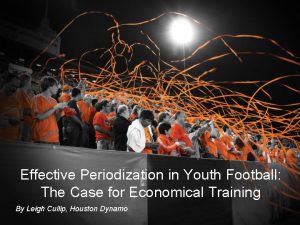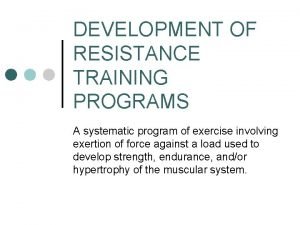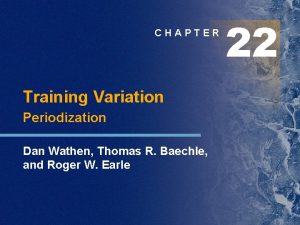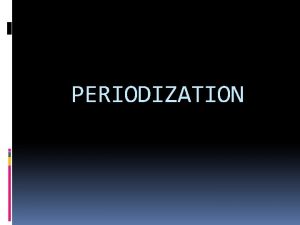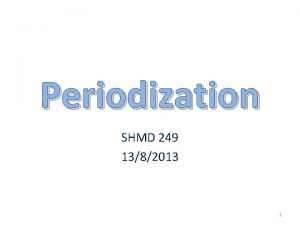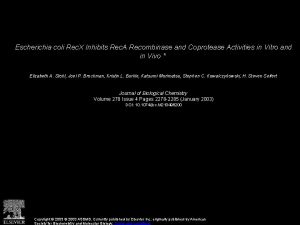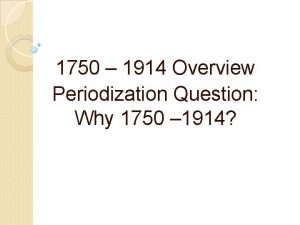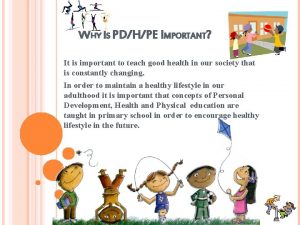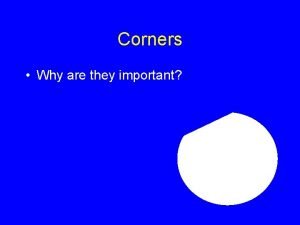REC 3045 Periodization Why is Periodization Important For































![Program Design [PF 30] • *Needs Analysis • • • evaluation of sport/assessment of Program Design [PF 30] • *Needs Analysis • • • evaluation of sport/assessment of](https://slidetodoc.com/presentation_image_h2/742883046363f175e74e034f46bf50f2/image-32.jpg)









- Slides: 41

REC 3045 Periodization

Why is Periodization Important? • For Peak Performance? • Systematic and Scientifically proven method • Allows training at the optimum level • For Injury Reduction? • Prevents overtraining without undertraining • For Non Athletic Populations? • Injury prevention with unknown levels of fitness

Why are Need Assessments Important? • Importance of Initial Consultation & Health Status • Reveals ability and level of work that the person can perform at • Reveals potential injury which could limit the person or harm them • Results in an appropriate program design for the person • Fitness Testing (Including Baseline Testing and Post. Training Testing) • Results become measurable

What are the following Acute Training Variables? • Exercises: Different exercises develop the body in different ways • Plyometrics, Power, Controlled Speed etc • Largest to Smallest unless we are targeting a muscle in a different manner • Develops power • Different recovery rates result in different reactions by the body • Order of Exercises: Controls the effect on the muscles • Repetitions: Number of reps determines how the body will react to the work • Sets: Amount of sets performed determines how the body will react • Tempo: Refers to the speed of the rep or workout • Rest: Determines how the body will recover • Load (Intensity): How hard we are working

Manipulate the Variables to Create Training Programs • Manipulate the variables to create the following programs: • Muscular Endurance • Hypertrophy • Max Strength • Power

The Traditional Periodization Model *4 periods -Preparatory Period -Hypertrophy/Endurance Phase -Basic Strength Phase -Strength/Power Phase -First Transition Period -Competition Period -Maintenance -Second Transition Period -Period of Active Rest

General Adaptation Syndrome • 3 Responses to Training Stress *Shock or Alarm Phase *Resistance Phase *Exhaustion Phase

Shock or Alarm Phase • Stress detected (alarm goes off) Fight or Flight response (adrenalin is produced) In Training, we want a Fight Response Training is a series of SHOCKS to our body that we want our body to FIGHT

Resistance Phase (Super Compensation) • Our body responds to stress by compensating • Compensating means getting stronger to meet the demands of the stress • So long as we allow enough time after the stress for the body to stronger compensate (Recover) it will get

Exhaustion Phase (Decompensation) • If we continually not allow enough time for the body to compensate (enough recovery time) it will decompensate or get weaker • When our body gets to the Exhaustion Phase it takes a great length of time before we get to supercompensation again (It is like having mono/body is rundown)

The Stress Rest Principle (Resistance/Exhaustion) RECOVERY A A B GROWTH A DECOMPENSATION (SUPERCOMPENSATION) RECOVERY TIME IN The body needs at least 2 days (48 DAYS hours) to recover. The greater the intensity the more recovery time

What is the First Transition Period of an ATP Periodization Model? • It is a period between the Preparatory Period and the competitive Period • Athletes typically Taper or Ramp their work • Tapering: Reducing workload to allow the body to fully recover so it is at its strongest for the competitive period • Ramping: Elevating the Intensity of the workload to simulate the intensity of the competitive period

What is the Competitive Period? • This is the time when games and competitions count • It is the highest level that the athlete will work at

What is the 2 nd Transition Period? • This is the time after the competitive period when the athlete needs to take a break from high competition to mentally and physically recuperate • Athletes will typically use Active Rest where they get involved in other activities that they enjoy while remaining active physically • They will not get involved in their sport

Specific Time Periods (Cycles) • *Macrocycles - 3 or more weeks of workouts • *Mesocycles - single workout or less • *Microcycles -1 -3 weeks of workouts • How will you use these 3 cycles in your 2 month periodized plan? Explain

4 Sport Seasons • *Off Season Period • *Pre Season Period • *In Season Period • *Post Season Period How do the 4 periods of the traditional periodization model fit into the 4 Sport Seasons?

Periods of Injury Rehabilitation Periodization Plan 1. ↓ swelling, pain, inflammation 2. ↑ ROM 3. ↑ muscular strength, endurance, power 4. Maintain cardiovascular fitness 5. Re-establish neuromuscular control 6. Improve stability and balance 7. Address psychological reaction to injury/pain 8. Posture & core stability 9. Protect/prevent further injury 10. Kinetic Chain/ Jt above/below 11. Functional Progressions- sport specific 12. Return to Activity Criteria 13. Home Program

Phases of Healing • Overlap with each other • Inflammatory Phase: 2 -4 days, SHARP/D, Goals; 13, 9 • Fibroblastic-Repair Phase: first few hours post injury to 4 -6 weeks, Goals; (1 -3), 4 -9, (10 -11) • Maturation- Remodeling Phase: 3 weeks to several years, Goals; (1 -9), 10 -13

• • • PRICE –Protect, Rest, Ice, Compression, Elevation for the first 72 hours Rest- Active Rest or AAROM (active-assisted ROM) Ice- Decreases pain, vasoconstriction of vessels to control hemorrhage(bleeding) and edema (swelling) Compression-decreases hemorrhage and hematoma formation Elevation- reduces internal bleeding Swelling, Pain and Inflammation


ROM (Range of Motion)/Flexibility • Several factors can limit flexibility and ROM: shape of jt, capsule, ligaments, mm, scars, neural tissue • Reflex Autogenic Inhibition: Golgi Tendon Organs = relaxation in antagonist mm • Flexibility can be lost quickly • Can be maintained with 1 session/week • Need 3 -5 sessions a week to improve!

• MUST use ALL 3 (ISOM, CONC, ECCEN) for program, watch out for Rehabilitative Overload • First weeks of program is focused on training to be efficient ex. Technique, target fiber and contraction • Strength directly related to efficiency of neuromuscular sys; increase motor unit recruitment, firing rate, enhancing synchronization of motor unit firing Muscular Strength, Endurance and Power

• Critical and often most neglected, improvements may be lost in as little as 12 days • Regardless of training schedule/techniques; Main goal is to increase ability of Cardioresp sys. to supply a sufficient amt of oxygen to the mm. • Upper vs Lower body injury Maintain Cardiorespiratory Fitness

• • • After injury, the CNS “forgets” how to put together information from mm and jt receptors Attempt to teach the body conscious control of a specific movement Requires many repetitions, from simple to complex movements CNS will compare the specific movement with stored information and adjust until any discrepancy in movement is corrected. MOST critical during the early stages of rehab to avoid reinjury Re-establish Neuromuscular Control

• • Involves integration of muscular forces, neurological sensory information, and biomechanical information Alignment of joint segments in an effort to maintain COG within an optimal range of the max limits of stability Static and Dynamic stability Associated with Closed Kinetic Chain (fixed base of support) Improve stability and Balance

• Psychological and sociological consequences of injury are just as debilitating as the injury itself • • • Can have an adverse impact on RTP • Maintain confidentiality! Barriers to rehabilitation Focus on prevention: Listen, Educate on injury and rehab, Goal setting, Meditation/Progressive Relaxation, Imagery, REFERRAL Psychological Reaction to Pain/ Injury

Posture and Core Stability • • Core= Lumbo-pelvic-hip complex, location of COG and where all movements begin Weak core= fundamental problem of many inefficient movements that lead to injury Inner (pelvic floor mm, TA, multifidus, diaphragm) and Outer unit (posterior oblique, deep longitudinal, anterior oblique, lateral) If one sys is out of alignment= patterns of dysfunction= Mechanical imbalance= bad posture (kyphosis, lordosis, sway back)

Protect and Prevent • Equipment= Helmets!, facial protection (face, throat, mouth, ears, and eyes), neck protecting, trunk and thorax, hips/ buttock, groin/ genetalia, upper leg, lower leg, footwear • Protect with injury= crutches, splints, tensors, tape, slings, foam padding • Rehab program must allow for Rest!

Kinetic Chain • Kinetic Chain- integrated functional unit, includes mm, fascia, ligaments, tendons, articular sys, and neural sys • Open- Kinetic Chain Exercise- distal segment is mobile and not fixed (foot or hand not in contact with ground or surface) • Closed-Kinetic Chain Exercise- when the distal segment of the lower extremity is stabilized or fixed

• A series of gradually progressive activities designed to prepare the individual for RTP • Progress from simple to complex sport specific skills • Skills are broken down into component parts and the athlete gradually reacquires those skills within the limitations of progress • May be broken down into 3 phases: stabilization, strengthening, power Functional Progressions

RTP Criteria • Physicians Release • Pain Free • No swelling • Normal ROM • Normal Strength • Mentally Prepared • Pass Functional Tests!
![Program Design PF 30 Needs Analysis evaluation of sportassessment of Program Design [PF 30] • *Needs Analysis • • • evaluation of sport/assessment of](https://slidetodoc.com/presentation_image_h2/742883046363f175e74e034f46bf50f2/image-32.jpg)
Program Design [PF 30] • *Needs Analysis • • • evaluation of sport/assessment of athlete *Exercise Selection exercise type/movement analysis of sport *Training Frequency training status/sport season/training load *Methods of Exercise Order power, core, assisted/upper & lower body push & pull/supersets & compound set

Program Design • *Various Training Loads one rep max/predicted one rep max • • loads based on training goals (hypertrophy/power/endurance/strength) *Various Rest Periods strength & power (2 -5 minutes) hypertrophy (30 seconds – 1. 5 minutes) muscular endurance (0 -30 seconds) • *Recovery 48 hours/72 hours

1. What is your sport and what are the needs of your sport? 2. What areas will you want to assess? 3. What are important movements of your sport? 4. What are the exercise types you will use? 5. What is your training status? Beginner/Intermediate/Advanced 6. What season are you in?

7. Outline the methods of exercise order? power/core/assisted upper/lower push/pull supersets/compound sets 8. Outline training loads? % of one rep max loads based on training goals (which programs and what are the goals) 9. Outline the rest intervals of each program?

Program Design (Aerobic) • *Various Exercise Modes running/biking/skipping/other • • *Various Training Frequencies *Various Training Intensities heart rate monitoring/perceived exertion • *Various Training Durations 70% VO 2 Max = several hours day/week/month

1. Outline the exercise progression you will use to train aerobically during your periodization plan? -increasing frequencies -intensities -duration -rest period of aerobic activity

MACROCYCLE MICROCYCLE MESOCYCLE Strength 1 Strength 2 Semi Final Hypertrophy 1 Hypertrophy 2 Hypertrophy 1 Circuit Hypertrophy 1 Hypertrophy 2 Competitive PERIOD OF PLAN Practice In Season Video Practice Short Practice Off Off Practice Game Video Practice Off Practice Semi Final Video Practice Off Practice SEASON SPORT SCHEDULEOF PLAY Sept 26 Sept 27 Sept 28 Sept 29 Sept 30 Oct 1 Oct 2 Oct 3 Oct 4 Oct 5 Oct 6 Oct 7 Oct 8 Oct 9 Oct 10 Oct 11 Oct 12 Oct 13 Oct 14 Oct 15 Oct 16 Oct 17 Oct 18 Oct 19 Oct 20 Oct 21 Oct 22 Oct 23 Oct 24 Oct 25 Oct 26 Oct 27 Oct 28 Oct 29 Oct 30 Oct 31 Nov 1 DATE PERIODIZATION PLAN Circuit Full Body W. O. Hypertrophy 1 Circuit Hypertrophy 1 Hypertrophy 2 Strength Testing PROGRA M REC 3045 NAME: Football/Rugby

MACROCYCLE MICROCYCLE MESOCYCLE Power Day 1 Power Day 2 Power Day 1 Power Day 2 Testing (Gym) Preparatory 2 nd Transition Rugby Gym Night DATE Nov 2 Nov 3 Post Season Nov 4 Nov 5 Nov 6 Nov 7 Nov 8 Nov 9 Nov 10 Nov 11 Nov 12 Nov 13 Off Season Nov 14 Nov 15 Nov 16 Nov 17 Nov 18 Nov 19 Nov 20 Nov 21 Nov 22 Nov 23 Nov 24 Nov 25 Nov 26 Nov 27 Nov 28 Nov 29 Nov 30 Dec 1 Dec 2 Dec 3 Dec 4 Dec 5 Dec 6 Dec 7 Dec 8 In Season Competitive Final Practice Championship SEASON SPORT SCHEDULEOF PLAY PERIOD OF PLAN PERIODIZATION PLAN Strength Testing (Gym) Strength 1 Strength 2 Strength 1 No Workouts Circuit Strength 2 PROGRA M REC 3045 Name: Football/Rugby

MACROCYCLE MICROCYCLE MESOCYCLE PERIOD OF PLAN SEASON SPORT SCHEDULEOF PLAY Competitive Practice In Season Off Practice Game Class Room 257 Off Post Season WC Leader Pres. Practice Class Room 257 Off WC Leader Pres. Practice ¼ final Game ¼ 1 final Game ¼ final Game 2 3 Hypertrophy 1 Off Hypertrophy 2 Practice Off Hypertrophy 1 Practice Muscle Activation Semi Game 1 Semi Game 2 Semi Game 3 Hypertrophy 1 Off Hypertrophy 2 Practice Hypertrophy 1 Practice Muscle Activation Final Game 1 Final Game 2 Final Game 3 Hypertrophy 1 Off Hypertrophy 2 Practice Hypertrophy Practice Full Prov Game 1 Prov Game 2 Prov Game 3 Off Season No Workouts 2 nd Transition Class Room 257 WC Testing Gym Testing WC MA Video Day PROGRA M Feb 21 Feb 22 Feb 23 Feb 24 Feb 25 Feb 26 Feb 27 Feb 28 Feb 29 Mar 1 Mar 2 Mar 3 Mar 4 Mar 5 Mar 6 Mar 7 Mar 8 Mar 9 Mar 10 Mar 11 Mar 12 Mar 13 Mar 1 4 Mar 15 Mar 16 Mar 17 Mar 18 Mar 19 Mar 20 Mar 21 Mar 22 Mar 23 Mar 24 Mar 25 Mar 26 Mar 27 Mar 28 DATE REC 3045 PERIODIZATION PLAN NAME: Hockey

MACROCYCLE MICROCYCLE MESOCYCLE PERIOD OF PLAN Testing (Gym) Class Room 257 Indy Pro Day #1 Game# 2 BBB WC Testing Game# 1 VBall Strength 1 Strength 2 Strength 3 Strength 1 Class Room 257 Strength 2 Class Room 257 Muscle Activation Strength 3 Strength 1 Strength 2 Class Room 257 Strength 1 Strength 2 Strength 3 Competitive Preparatory No Workouts 2 nd Transition PROGRA M Junior Spring Camp Junior Testing Pre Season Off Season SEASON SPORT SCHEDULEOF PLAY Mar 29 Mar 30 Mar 31 April 2 April 3 April 4 April 5 April 6 April 7 April 8 April 9 April 10 April 11 April 12 April 13 April 14 April 15 April 16 April 17 April 18 April 19 April 20 April 21 April 22 April 23 April 24 April 25 April 26 April 27 April 28 April 29 April 30 May 1 May 2 May 3 May 4 DATE REC 2910 PROJECT B: PERIODIZED PLAN Name: Hockey
 Tactical periodization youth soccer
Tactical periodization youth soccer Periodization training
Periodization training Matveyev's model of periodization
Matveyev's model of periodization Andreas carlsson bye bye bye
Andreas carlsson bye bye bye Dont ask
Dont ask From most important to least important in writing
From most important to least important in writing From most important to least important in writing
From most important to least important in writing Least important to most important
Least important to most important Kontinuitetshantering
Kontinuitetshantering Novell typiska drag
Novell typiska drag Tack för att ni lyssnade bild
Tack för att ni lyssnade bild Vad står k.r.å.k.a.n för
Vad står k.r.å.k.a.n för Shingelfrisyren
Shingelfrisyren En lathund för arbete med kontinuitetshantering
En lathund för arbete med kontinuitetshantering Personalliggare bygg undantag
Personalliggare bygg undantag Tidböcker
Tidböcker Anatomi organ reproduksi
Anatomi organ reproduksi Förklara densitet för barn
Förklara densitet för barn Datorkunskap för nybörjare
Datorkunskap för nybörjare Stig kerman
Stig kerman Debattartikel mall
Debattartikel mall Delegerande ledarstil
Delegerande ledarstil Nyckelkompetenser för livslångt lärande
Nyckelkompetenser för livslångt lärande Påbyggnader för flakfordon
Påbyggnader för flakfordon Kraft per area
Kraft per area Offentlig förvaltning
Offentlig förvaltning Kyssande vind analys
Kyssande vind analys Presentera för publik crossboss
Presentera för publik crossboss Teckenspråk minoritetsspråk argument
Teckenspråk minoritetsspråk argument Kanaans land
Kanaans land Klassificeringsstruktur för kommunala verksamheter
Klassificeringsstruktur för kommunala verksamheter Epiteltyper
Epiteltyper Bästa kameran för astrofoto
Bästa kameran för astrofoto Cks
Cks Programskede byggprocessen
Programskede byggprocessen Bra mat för unga idrottare
Bra mat för unga idrottare Verktyg för automatisering av utbetalningar
Verktyg för automatisering av utbetalningar Rutin för avvikelsehantering
Rutin för avvikelsehantering Smärtskolan kunskap för livet
Smärtskolan kunskap för livet Ministerstyre för och nackdelar
Ministerstyre för och nackdelar Tack för att ni har lyssnat
Tack för att ni har lyssnat Referatmarkering
Referatmarkering
